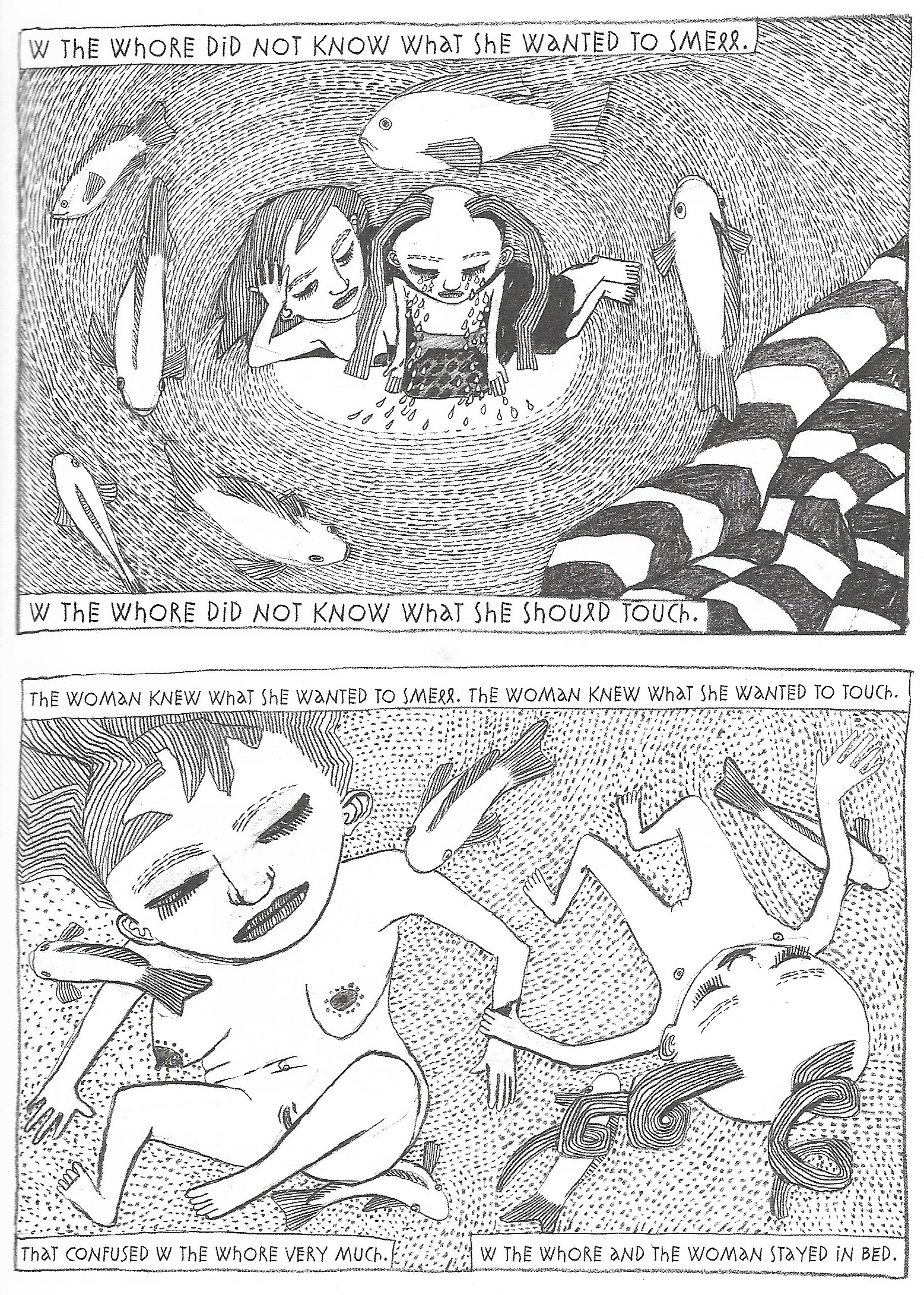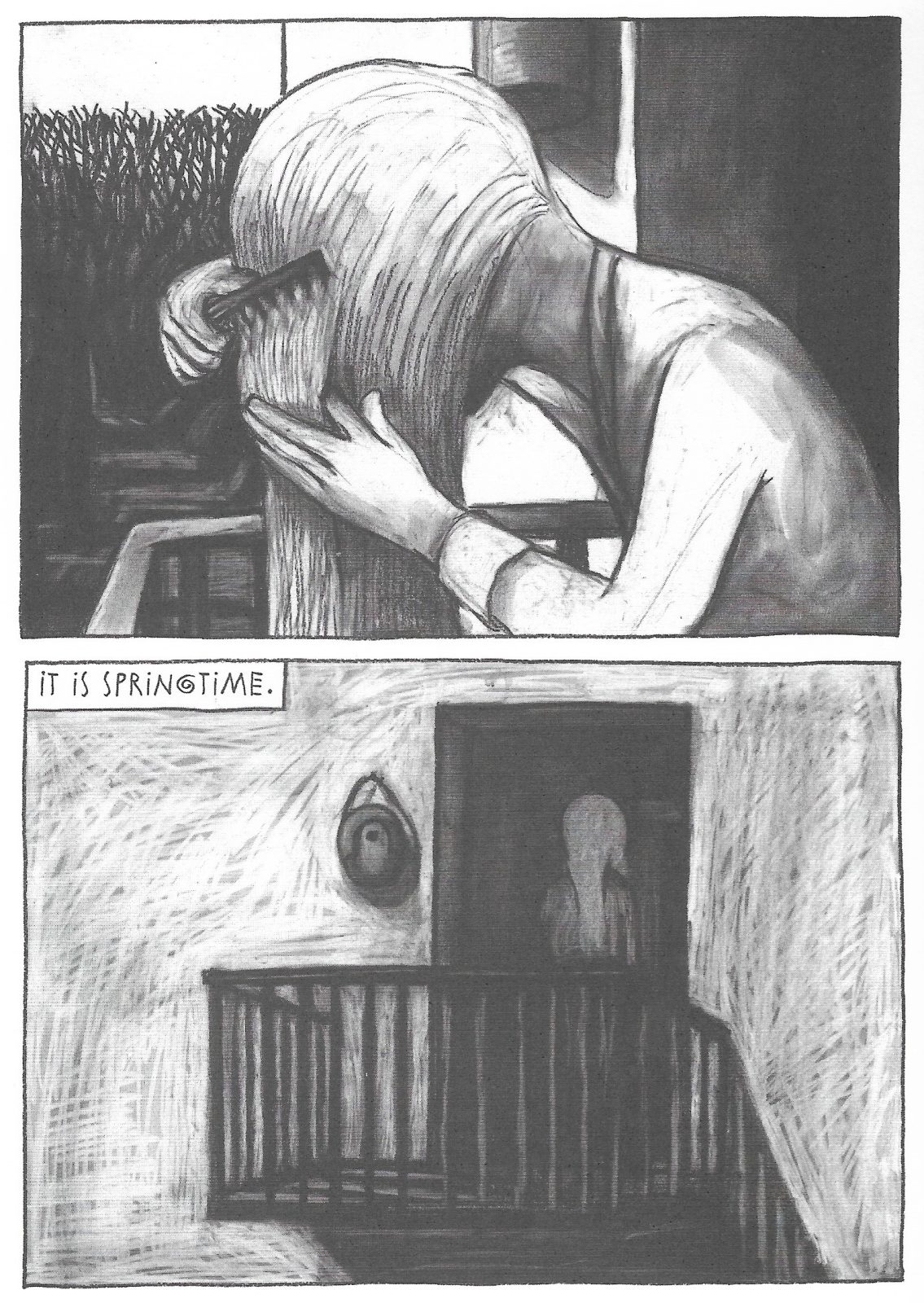What is a whore? A whore is political. A whore is a sex worker, a free lover, an outsider, an expensive gift, a woman, a woman-like object, sexually obtainable, socially apart. A symbol of decline or revolution, failure or absolution. If woman is not man, a whore is the woman who is not woman - the liminal space of impermissible femininity, inscrutably tough and passive. Whore is an insult, a rallying cry, a person, (or) a contradiction. W the Whore is a succession of comics formed out of disconnection and rupture. Its creators came together from opposite sides of the Berlin Wall’s rubble, and the resulting nine stories concern the violent confusion enacted on women’s bodies by patriarchy, the labyrinthine structures women are placed within under patriarchy’s chilling shadow, and the mounting contradictions enacted upon women deemed to be whores.

W the Whore began as a written correspondence between Katrin de Vries and Anke Feuchtenberger, the former a writer in West Germany, the latter an artist in East Berlin, brought together after the German reunification. De Vries wrote an enigmatic text–not a script, but statements–which Feuchtenberger brought to life with the occasional short comic over more than a decade's time. As Feuchtenberger has mentioned, W the Whore is a character without a fixed appearance, and the artist's illustrations intentionally transformed and distorted de Vries' words. The titular metaphorical action in the story "The Tracks" (as in 'making tracks') became the creation of a literal train track. Attending a ball became a journey into the interior of a sphere in "The Ballroom".
W the Whore begins her life as a woman who experiences needs in the absence of desires and curiosity in the absence of fulfillment. She is captured by amorous men and scorned by incredulous women. When we first meet the character, she seeks to desire a man, and upon finding the man discovers herself unable to desire him, although he desires her repeatedly. Her attempt to desire a woman is likewise disappointing for her while pleasing to the woman she sought. She visits a birthing house and cannot enter its narrow passage. She wears a white wedding dress and is buffeted by winds, finding her outfit soiled and stripped away before she can find anyone to wed. She makes tracks: journeys to destinations which repel her, leaving her to pursue some other need, chase down some other meager dream.

In its early pieces, it is possible to read W the Whore as a didactic meditation, the groundwork of a feminist dialectic. They are stories about a woman excluded from society, seeking pleasure within patriarchy despite her state of dissociation, culminating in her rejection of that world with pride and sorrow. The allegorical climax of this phase culminates in her shedding a white wedding dress–now dirty, black and ruined–standing naked in the rain, the dream of marriage forgotten before the cold and naked bliss of freedom. But by the time W the Whore makes her tracks, the blissfully legible dream logic of allegory drops away. W the Whore is free, but what good is freedom? At the end of her tracks, W the Whore bares witness to another whore, a sexed creature outside of her comprehension, locked in her gaze. From here, the reasonable clarity of ennui expands into the creeping dread of existential nightmares. Sex, trauma, isolation and vengeance continue to reverberate throughout the book's later pieces - indeed, sexual violence and the familiar oppressive specter of patriarchy erupt more vividly than ever. But the meaning is less sure. Men turn into babies; towers of corpses sprout out of the shadows with paths to undefined labyrinths. W the Whore fades into the darkness and her motives become as obscure as her body; her breasts swell and explode; her frame grows and shrinks and her face fades to a hollow blankness. She is a dweller of some great panopticon - perhaps she is watching over her own capture.

Feuchtenberger’s illustrations grow more obscure in turn, both in their increasingly wild interpretive wanderings off the beaten path of de Vries’ text and in the transformation of the artist's style. What begins as a bluntly cubist representational line becomes an expressionist charcoal smudge, overwhelmingly textured darkness bearing the murk of possible meanings. Every mark made hides another secret. Day becomes night, every new texture sculpts a muted scream. The textured depth of Feuchtenberger’s evocative line sadly arrives somewhat dulled by the faded and grey image transfers used by NYRC in this collected edition, which follows a German omnibus published last year by Reprodukt. Readers of this otherwise wonderful new collection, which also includes a fantastic interview with the writer and artist conducted by Madeleine Schwartz and an informative introduction by the translator Mark Nevins, may wish to seek out the finely-crafted English editions the Belgian publisher Bries released in the '00s (W the Whore, 2001; and W the Whore Makes Her Tracks, 2006), although they only cover six of the nine stories here.

Who is W the Whore? W the Whore is a liminal space. W the Whore is a womanwhore without a fixed appearance, ambition, profession, place, emotion. She is a woman who desperately wants to desire and does not desire despite the desire of others. Her terrain shifts before her eyes, squeezing her out, holding her tight. She lives in ruptured gaps between boundaries of nations, between men and women, between conscious and subconscious. She is a nocturnal emission sent forth from the yonic wounds of a stateless body's aching mind. A painful pleasure. Just beyond description.
The post W the Whore appeared first on The Comics Journal.





No comments:
Post a Comment